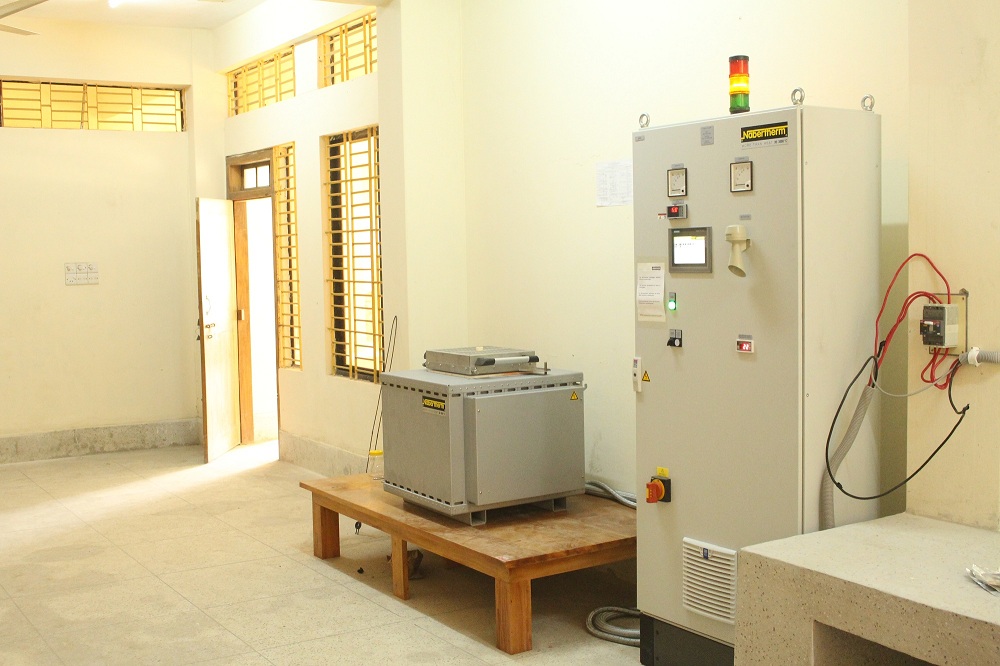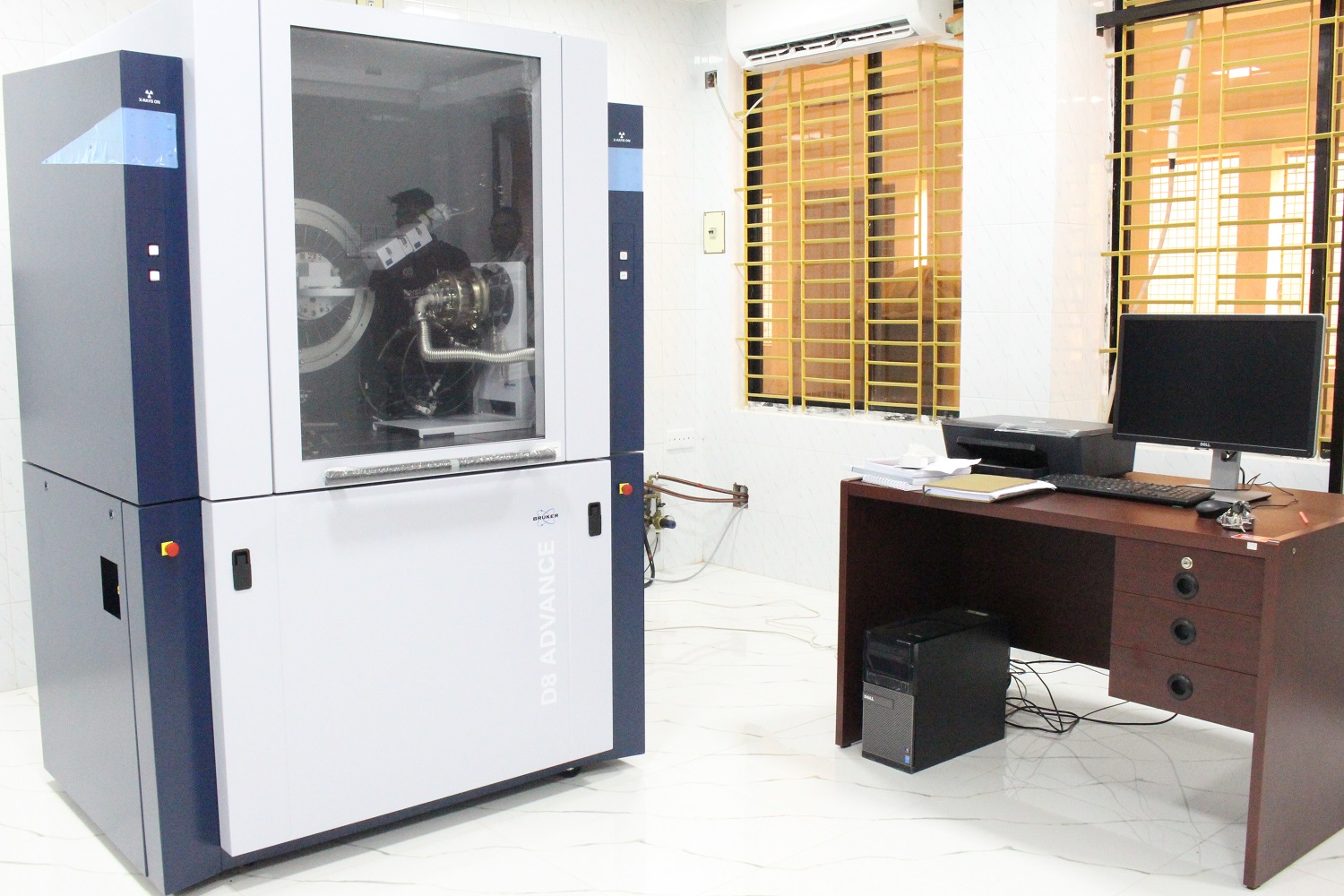The department of Glass & Ceramic Engineering has a number of facilities to meet up the requirements of undergraduate studies. This department provides 10 different laboratory facilities with advanced and traditional tools and machineries to elucidate the fundamental engineering concepts for B.Sc. Engineering students. These laboratories are used for demonstration of sessional courses, performing project and thesis of undergraduate students and carrying out research to develop the glass and ceramic engineering sector. The laboratories are
1. Glass Forming Laboratory

Glass forming laboratory is the fundamental laboratory for the forming different types of glass in different techniques. This laboratory provides facility for glass forming as well as glass testing. There have a number of modern Glass Melting Furnaces. The glass making process becomes easier with this modern furnace. Students can make glass from desired batch composition. They can melt the batch in the furnaces that subsequently form glass.
2. Chemical Analysis Laboratory

Chemical analysis laboratory is designed for the sessional classes on quantitative and qualitative analysis of glass and ceramic materials. This lab is facilitated with pH meter, digital water bath, magnetic stirrer, fume chamber and hundreds of chemicals and raw materials. In this lab students can determine the pH value, Chemical analysis of cement, glass & ceramics, corrosion rate of metals and alloys, heating up chemical elements by using digital water bath, drying & mixing of powder solution using magnetic stirrer.
3. Material Characterization Laboratory
Material characterization lab is the most important lab for GCE dept.The primary mission of this lab is to enabling the students to analyze and characterize the structure and properties of different materials. In this lab, students are introduce with various types of materials characterization instruments such as Micro Hardness Tester, Impact Resistance Tester, Pycnometer, Impedance Analyzer, Dilatometer, Differential Scanning Calorimeter (DSC), Thermal Conductivity Meter, Annealing Point Measuring Unit.
4. Ceramic Forming Laboratory

It is the core lab for GCE dept. This lab is equipped with modern facilities and ceramic forming instruments including Planetary Ball Mill, Assembly Ball Mill, Jaw Crusher, Vibratory Sieve Shaker, Jiggering & Jollying machine, Hot Plate, Electric Dryer, Muffle Furnaces and Electric Kiln.
In this lab student can learn the total ceramic forming steps i.e. processing of raw materials to forming the ceramic products. They can crush the raw materials of desired size, ball mill the powder to make slip & slurry, prepare the mold, form the hollow & flat shape ceramic ware by slip casting, jiggering & jollying machine, drying & firing of ceramic bodies by electric dryer, muffle furnace and electric kiln.
5. Nano Synthesis Laboratory

A Nano synthesis laboratory is one of the most important laboratories in Glass & Ceramic Engineering department. Modern facilities have been developed for theoretical & advance ceramic. This lab is equipped with modern Refractometer, Ultrasonic Cleaner, Electrometer, UV-visible Spectrophotometer, Glass Softening Point Tester, Electric Balance Three Point Bending tester, Flame Photometer, Viscosity Tester and Hydraulic Hot Press equipment.
In this lab students can learn about the different synthesis and characterization technique of nanomaterials. They can perform the following measurement like refractive index of materials, Optical constants (Transmittance & Absorbance) both for solids an liquids, Electrical resistance, Charge & current of ceramic materials, Glass softening temperature of different glasses, Modulus of rupture of ceramics, Elemental analysis usually Li, Na, K, Ca & Ba containing materials, Absolute, Apparent & Kinematic viscosity of ceramic slip and slurry.
6. Materials Testing Laboratory

Different types of materials can be precisely tested in this lab with advanced instruments. This lab is rich with modern facilities and instruments.
Student can learn the procedure of handling the following machines such as Universal Testing Machine(UTM), Surface Grinder, Cutting Machine and Lathe machine.
Students can perform the Tensile & Compressive strength by UTM, Surface cleaning by Surface grinder, cutting, tooling, grinding, finishing, machineries making by Lathe machine.
7. Microstructure Analysis Laboratory

Investigation of microstructure of materials is very important for materials science. Any changes of microstructure of materials can also changes the properties. So, laboratory for microstructure investigation is essential for the students of GCE department.
The microstructural analysis laboratory of this department is enriched with modern facilities and instruments including metallurgical microscope, Optical microscope, Microscope with image analyzer. Student can analyze the microstructure of metal, ceramics and glass. Microscope with Image analyzer is used to explore the micrograph of different materials.
8. Computer Laboratory

This laboratory is furnished with computing facilities for the sessional courses on programming like C, C++, CAD-CAM, Adobe Photoshop, Adobe illustration, and Solid works software. It is also networked with the campus server, which assists the research activities in the department.
9. XRD Laboratory

XRD is associated with quantitative phase identification and structural analysis with Bragg-Brentano geometry and scintillation detector. To keep pace with advance ceramic research, XRD laboratory have been established in GCE department. The general features of XRD machines are
· Temperature Range: RT to 1600oC (max.)
· Sample compatibility: Powder, Solid, Thin film
· Applications: Ceramics, Metals, Refractories, Mineral, Cements, Cellulose, etc.
10. SEM Laboratory

Scanning Electron Microscopy (SEM)is one of the most important morphological analysis techniques of materials. SEM provides excellent quality imaging results from an analytical microscope with the capability to handle all types of material.
v Magnification: 0-10,00000X (max.)
v Imaging modes: Surface and cross-sectional
v Sample compatibility: Thin film, solid, powder, fiber, etc.